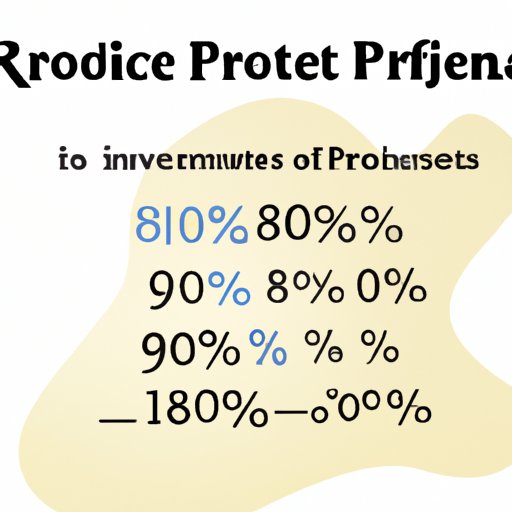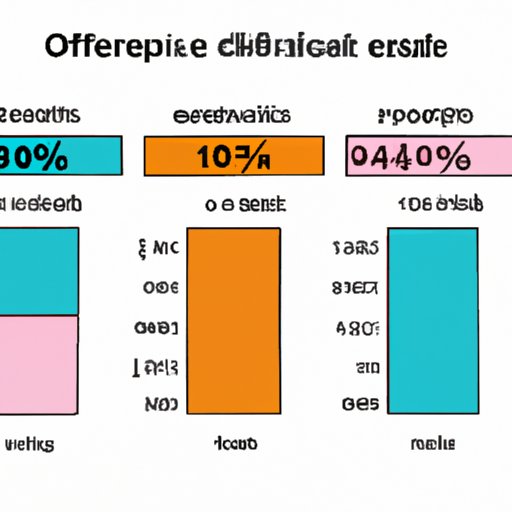Introduction
Percentiles provide a way to compare individuals or groups to one another by dividing a population into 100 equal parts, thereby allowing for comparison of relative performance. Knowing how to understand and calculate percentiles is an invaluable skill that can be used in education, healthcare, and business.

An Explanation of How Percentiles Work
In order to understand how percentiles work, it is important to begin with the definition of percentile. A percentile is a measure of position within a given set of data, where the position is expressed as a percentage. For example, if someone is in the 75th percentile, they have performed better than 75% of the people in the group.
The percentile is calculated by taking the number of values that are lower than the value you are measuring and dividing it by the total number of values. This number is then multiplied by 100 to get the percentile score. It is important to note that the percentile is not the same as the percentage. The percentile is a measure of position, while the percentage is a measure of value.

A Guide to Calculating Percentiles
There are two main methods for calculating percentiles: the formula method and the statistical software method. The formula method involves taking the number of values that are lower than the value you are measuring, dividing it by the total number of values, and multiplying this number by 100. The statistical software method involves using statistical software such as Excel or SPSS to quickly and accurately calculate the percentile.
Examples of Percentile Usage in Different Fields
Percentiles are used in a variety of different fields, including education, healthcare, and business. In education, percentiles are often used to compare student performance on tests and other assessments. In healthcare, percentiles are used to compare patients’ health outcomes against population norms. In business, percentiles are used to compare performance across teams, departments, or organizations.
The Different Types of Percentiles
There are several different types of percentiles that can be used. The most common are quartiles, deciles, and percentiles. Quartiles divide the population into four equal parts; deciles divide the population into ten equal parts; and percentiles divide the population into 100 equal parts. Each type of percentile has its own advantages and disadvantages, depending on the application.
Using Percentiles to Compare Performance
Using percentiles to compare performance can be advantageous in certain situations. One advantage is that it allows for a quick and easy comparison between individuals or groups. Furthermore, it allows for comparison across different populations, since the percentiles are based on the entire population, not just a specific subset.
However, using percentiles to compare performance can also be disadvantageous. One disadvantage is that it does not take into account any individual differences between individuals or groups, such as age, gender, or experience. Additionally, it can be difficult to determine which percentile is most meaningful in a given situation.

Exploring the Benefits of Knowing Percentiles
Knowing how to understand and calculate percentiles can be beneficial in many ways. Understanding your own performance in relation to others can help you make more informed decisions about your future. Additionally, being able to compare performance between different groups can help you identify areas for improvement.
Furthermore, understanding how to use percentiles can help you make more informed decisions about hiring and promotion. By understanding how to calculate and interpret percentiles, you can better assess potential candidates and make sure that you are making the best decision for your organization.
Conclusion
In conclusion, understanding and calculating percentiles is an invaluable skill that can be applied in a variety of different fields. Knowing how to calculate and interpret percentiles can help you make more informed decisions about your own performance, as well as the performance of others. Understanding the different types of percentiles and their uses can also help you make more informed decisions about hiring and promotion.
Overall, understanding percentiles is an important tool that can help you make better decisions and understand the performance of individuals and groups. Knowing how to use percentiles effectively can be a great asset in any field.
(Note: Is this article not meeting your expectations? Do you have knowledge or insights to share? Unlock new opportunities and expand your reach by joining our authors team. Click Registration to join us and share your expertise with our readers.)
